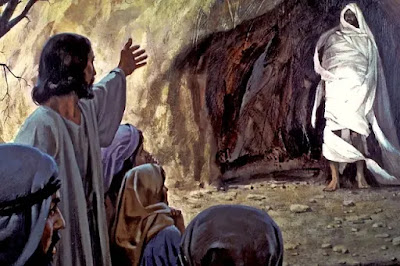Friday, March 31, 2023
THE GHOSTLY ALTAR BOY
Monday, March 27, 2023
DAMENGGON LÅSARO
|
DAMENGGON
LÅSARO (LAZARUS SUNDAY) (cover statues) |
Monday |
Tuesday |
Wednesday |
Thursday |
Friday |
Saturday |
|
DAMENGGON RÅMOS (PALM SUNDAY) Start of
Holy Week (Semåna
Sånta) |
Holy
Monday |
Holy
Tuesday |
Holy
Wednesday |
Holy
Thursday |
Good
Friday |
Holy
Saturday Statue veils
come off at Vigil Mass |
|
EASTER
SUNDAY |
|
|
|
|
|
|
DAMENGGON LÅSARO
Es posible que notara el domingo pasado, si asistió a misa,
que su parroquia cubrió las imágenes del altar. No todos los templos católicos
hacen esto, pero todos lo hacían antes de la década de 1960 y la costumbre
parece estar regresando a la mayoría de las iglesias en las Islas Marianas.
Estamos a dos semanas del amargo sufrimiento y crucifixión
del Señor, tiempo en el que las imágenes están cubiertas. La Iglesia quiere que
sintamos la pérdida del Señor. Fue arrestado y llevado. Encarcelado, estuvo
ausente de Su Madre y Sus discípulos por ese tiempo. Nosotros también
deberíamos sentir algo de su sentido de pérdida cuando se lo llevaron.
Dos domingos antes de Semana Santa fue llamado en chamorro
por nuestros “mañaina” (ancianos) DAMENGGON LÅSARO.
¿Cuál Lázaro?
Lázaro, el amigo de Jesús, que murió y que Jesús lo devolvió
a la vida incluso después de haber sido enterrado varios días en su tumba.
Bueno, ésa fue la gota que colmó el vaso para los enemigos
de Jesús. Superados por Jesús, sus enemigos resolvieron darle muerte, y la bola
comenzó a rodar lo cual conducía a su arresto y crucifixión.
Pero, ¿por qué este domingo lleva el nombre de Lázaro?
En el Misal (libro de oraciones de la Misa) usado en España durante un tiempo, y todavía se usa en algunas partes del país, se tomó del Evangelio, para el domingo anterior al Domingo de Ramos, la historia de la resurrección de Lázaro. Así, en España, el domingo anterior al Domingo de Ramos se llamaba DOMINGO DE LÁZARO, y como los misioneros católicos en las Islas Marianas eran mayoritariamente españoles hasta finales de los años 30, nuestros “mañaina” (ancianos) lo llamaban así, pero usando la versión chamorra del nombre: DAMENGGON LÅSARO.










